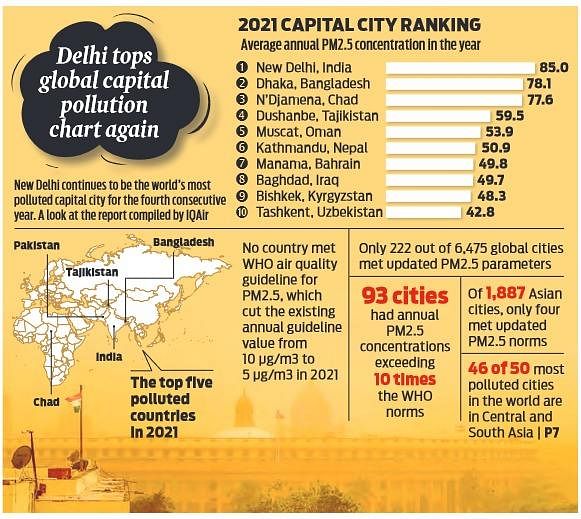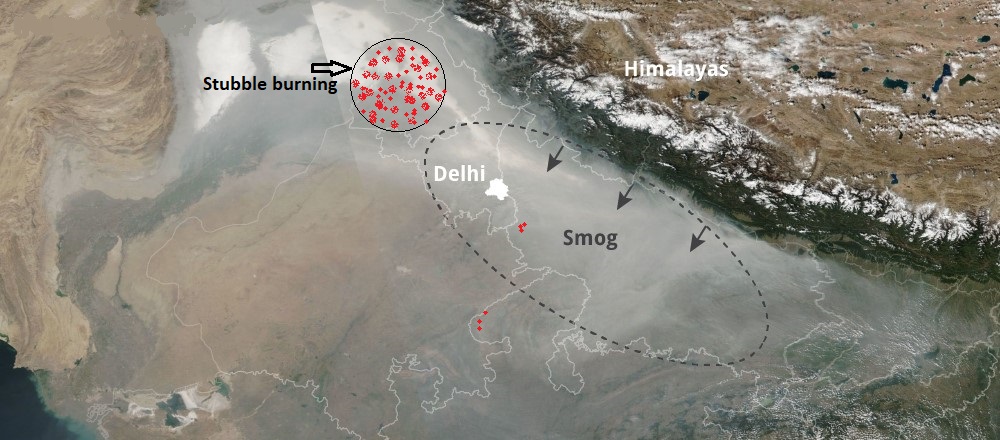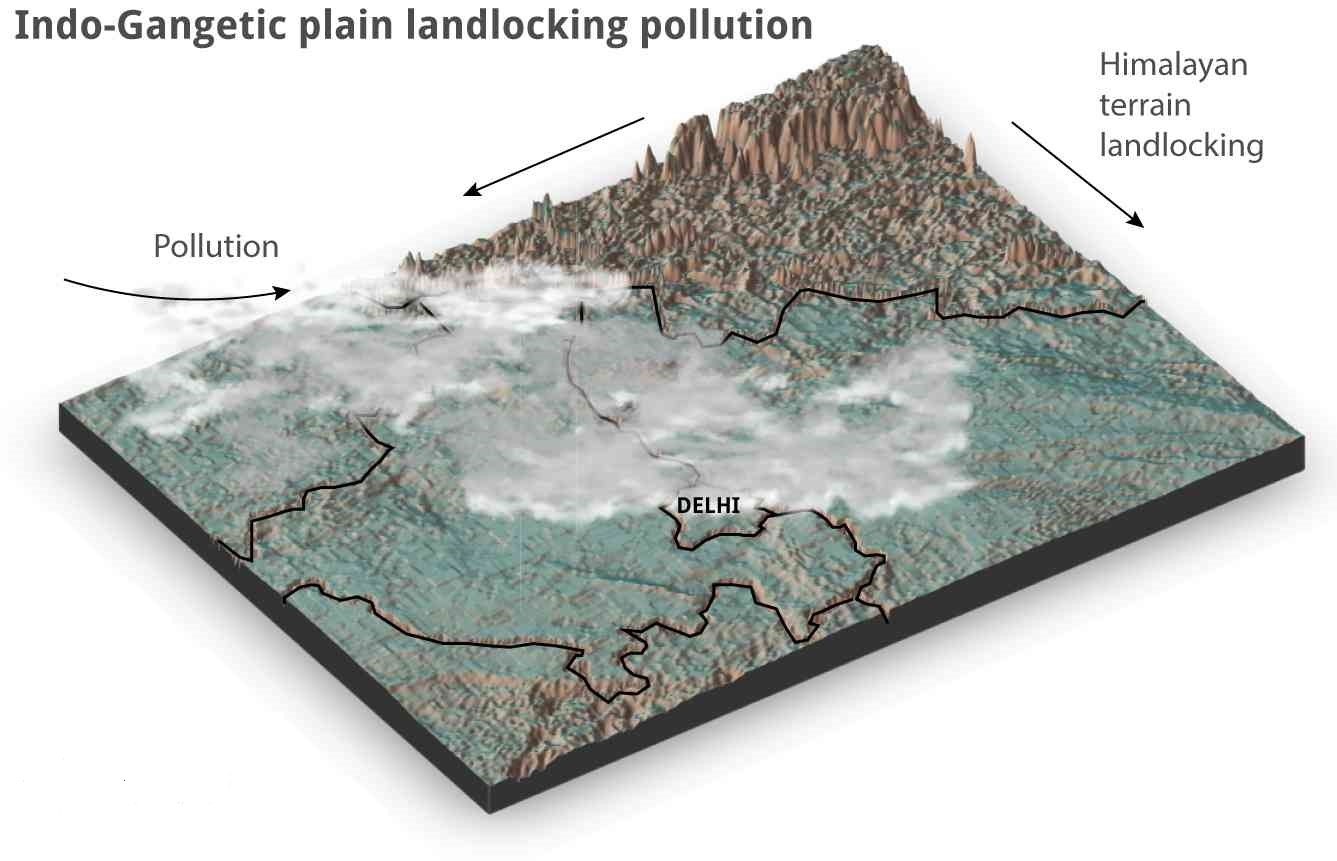Air Pollution in India
2022 NOV 11
Mains >
Environment & Ecology > Pollution > Air pollution
IN NEWS:
- Delhi witnessed very poor air quality, sticking to the trend that has existed during winter months for some years now.
STATISTICS:
- According to the World Air Quality Report 2021, 63 of the world's 100 most polluted cities are in India.
- India's annual PM2.5 averages have returned to pre-quarantine concentrations as measured in 2019. In 2021, 48 per cent of Indian cities exceeded 50µg/m3, or more than 10 times the WHO guideline.

- In the Environmental Performance Index 2022, India is at 179th rank in the air quality indicator.
- Air pollution caused an estimated 1.6 million deaths in 2019 in India: the highest in the world, according to the report by the Lancet Commission on Pollution and Health.
- More than 1,10,000 infants are likely to have been killed by air pollution in India in 2019.
- Air pollution shortens the average Indian life by roughly 3.4 years, according to a study by the Indian Institute of Tropical Meteorology.
MAJOR CAUSES OF AIR POLLUTION IN INDIA:
- Agricultural activities:
- Use of insecticides, pesticides and fertilizers in agricultural activities release ammonia which is a major air pollutant.
- Crop residue burning: Large-scale burning of crop residues from paddy crop in October-November and then wheat in April in Punjab, Haryana and western Uttar Pradesh contributes significantly to the air pollution in the Delhi NCR Region every year.
- Crop fires also led to higher levels of surface ozone
- High dependence on coal for power:
- Share of coal in power generation in India continue to be around 80%.
- Coal power plants with poor technology and efficiency continue to be the major source of pollutants like CO and oxides of nitrogen and sulfur.
- Fuel adulteration:
- Adulteration of gasoline and diesel with lower-priced fuels is common in India, hence beating the purpose of fixing fuel standards.
- Some adulterants increase emissions of harmful pollutants from vehicles, worsening urban air pollution
- Mining operations:
- During the process of mining, dust and chemicals are released in the air causing massive air pollution.
- Pollution from transportation sector:
- Transportation sources account for approximately a third of PM pollution in India, and a somewhat higher proportion of nitrogen oxides
- India’s vehicle fleet is growing rapidly as it increased from about 10 million in 2007 to over 21 million in 2016.
- Industrial pollution:
- As per TERI’s inventory industrial sector contributes 36% of total PM2.5 emissions. This includes pollution due to burning of fossil fuels, chemical solvents by tanning industries, releasing untreated waste into the environment, improper disposal of radioactive material.
- High levels of poverty:
- Dependence on fuelwood and kerosene for the purpose of lighting and cooking leads to a high level of pollutants being released in the rural and urban periphery.
- Overexploitation of resources like forests, grazing lands and mindless deforestation reduces the natural capacity to absorb pollutants.
- Climate change:
- Elevated air pollution levels is also a result of climate change events, such as sandstorms and wildfires,
- Administrative issues:
- Poor governance:
- While agencies liked CPCB and SPCBs continue to be under-resourced and under-staffed, the multiplicity of the state authorities at the ground level leads to poor coordination, lax enforcement of rules and lack of accountability as seen in Delhi.
- Absence of environmental governance continues to be a major challenge.
- Poor enforcement of rules:
- The Air (Prevention and Control of Pollution) Act was passed in 1981 to regulate air pollution but has failed to reduce pollution because of poor enforcement of the rules.
- Unplanned urbanization:
- Rapid growth of urban areas has led to the proliferation of slums and poor public transport has increased the burden of personal vehicles on the road.
- Landfills used for waste management also release pollutants in the air.
- Poor access to technology:
- India’s industrial landscape continues to be dominated by MSMEs which lack access to cleaner technologies. Agricultural waste burning is also the result of poor access to farm technologies.
- Cultural reasons:
- Fire crackers are part of festivals such as Diwali. Stringent regulations during Diwali has been difficult due to people’ reluctance.
WHY DELHI SUFFERS THE MOST?

- Landlocked region:
- Delhi is a land locked city without having any moderating effect. As crop burning begins in September-November, slow winds from the north west begin to slowly push the air towards the plains of Haryana, New Delhi and Uttar Pradesh. With the Himalayas forming a huge barrier to the north, the air begins to accumulate in the region and is unable to escape.

- Winter conditions:
- In winter season, wind speeds reduce significantly. Hence, mobility of dust particles and pollutants in the air reduces and these pollutants get locked in the air, resulting in smog.
- Environmental degradation:
- Due to loss of green cover over the adjacent Aravallis, atmospheric moisture and number of rainy days in Delhi has seen significant reduction in recent times. This adds to the amount of dust in atmosphere.
- High population density:
- With nearly 3 crore people, Delhi is one of the most populated cities in the world. The uncontrolled urbanisation has resulted in large-scale construction, pollution, burning of waste etc. thereby increasing dust and pollution in the air.
- Proximity to polluting sources:
- Delhi has several sources of air pollution such as thermal power plants, vehicular emissions and firecrackers during Diwali celebrations.

INITIATIVES TAKEN:
- Legislative framework:
- The Air (Prevention and Control of Pollution) Act, 1981
- It provides for the prevention, control and abatement of air pollution and for the establishment of Boards at the Central and State levels
- The Environment (Protection) Act,1986:
- It is an umbrella legislation designed to provide a framework for the co-ordination of central and state authorities established under the Water Act, 1974 and Air Act,1981.
- Centre has notified Dust Mitigation Plan under EPA to arrest dust pollution.
- Schemes/programmes:
- National Clean Air Programme:
- It was formulated to tackle air pollution in cities, specifically to reduce particulate matter (PM2.5) pollution by 20%-30% from 2017 levels by 2024.
- It calls for:
- Augmentation of existing air quality monitoring network by increasing number of existing manual and continuous monitoring stations,
- Introducing rural monitoring stations
- Identifying alternative technology for real-time monitoring network
- Augmenting capabilities of existing monitoring stations to measure PM2.5 concentration
- National-level emission inventory
- Launch of National Air Quality index (AQI):
- The AQI classifies air quality of a day considering criteria pollutants through colour codes and air quality descriptor.
- Further, it also links air quality with likely human health impacts.
- Notification of Graded Response Action Plan for Delhi and NCR identifying source wise actions for various levels of air pollution
- National Ambient Air Quality Standards:
- According to the revised NAAQS, the acceptable annual limit for PM2.5 is ??40 micrograms per cubic metre (µg/m3) and 60 µg/m3 for PM10.
- However, the renewed WHO standards, prescribe an accepted annual average of 5 µg/m3 for PM2.5 and 15 µg/m 3 for PM10.
- To control vehicular pollution:
- Setting emission standards:
- Bharat Stage Emission Standards (BSES) was introduced in 2000, to keep air pollutants emitted by the internal combustion engine of vehicles under control.
- In March 2017, the Supreme Court banned the sale of BS III vehicles in the country.
- It it expected that BS VI can bring PM and nitrogen oxides in diesel cars down by 80 per and 70 per cent respectively.
- FAME (Faster Adoption and Manufacturing of (hybrid &) Electric vehicles:
- To incentivize the production and promotion of eco-friendly vehicles including electric vehicles and hybrid vehicles
- Promotion of public transport network, through measure like development of rapid transit system and odd-even policy.
- Initiatives to curb indoor air pollution:
- Pradhan Mantri Ujjwala Yojana where subsidised Liquefied Petroleum Gas (LPG) connections were provided to women of the poor households
- Measures to curb industrial pollution:
- The Central Pollution Control Board (CPCB) has laid down the maximum permissible limits for different pollutants for many categories of industries that contribute to air pollution.
- In October 2017, Supreme Court banned the use of pet coke and Furnace Oil for combustion in the states of Delhi, Haryana, Rajasthan and Uttar Pradesh
SUGGESTIONS:
- Tackling indoor air pollution:
- Efforts towards reducing IAP have to expand beyond mere provisions of clean cooking fuels.
- Repeated awareness creation on the benefits of clean cooking is to be embedded in the clean cooking programmes.
- In the short run, improving the ventilation in rural kitchens may be an option
- Complete transition to clean fuels will also depend on the economic status of the households and level of awareness on clean cooking fuels
- Public Transport:
- The push for public transport has long been highlighted as a potential solution. However, we are far from implementing it on the ground.
- The current public transport system is disintegrated. We need to integrate it physically ensuring that it is reliable, comfortable and provides last mile connectivity but without additional cost.
- Better waste management:
- Open burning of municipal solid waste and industrial waste is fouling up the air.
- The need is to build institutional capacity for implementation and enforcement and have the necessary legal back-up for compliance and strong deterrence.
- Promotion of renewables:
- Addressing the problem of intermittence by adopting smart grid technology, incentives for decentralised power production via biogas, rooftop solar and push to EVs.
- The management of agricultural waste:
- The problem of crop burning can be resolved only through financial and technological support and incentives for farmers.
- Access to technologies like happy seeder machines and PUSA decomposer and the development of the market for crop stubble will push farmers to a cleaner method of waste disposal.
- Promote coordination:
- Management of air pollution sources, particularly those across state boundaries such as stubble burning, require high levels of co-ordination and co-operation. For this, the current administrative and legal framework needs to be reformed.
BEST PRACTICES:
- Beijing’s air quality management system:
- Beijing implemented a series of measures focused on energy infrastructure optimization, coal-fired pollution control, and vehicle emission controls
- In the five years from 2013 to 2017, fine particulate pollution (PM2.5) in Beijing fell by 35% and sulphur dioxide dropped by 83%.
- Airshed management:
- Airshed refer to the entire area over which the pollutants disperse due to meteorological and geographical factors.
- The concept is very similar to ‘watershed’ and includes the public, industry and local governments as important stakeholders.
- The approach recognizes that poor air quality can often be the result of the cumulative impact of a multitude of activities and emission sources and this is often exacerbated by topographical and meteorological conditions that do not allow dispersion of pollutants.
- Airshed-based air quality management has been successfully tried in many places across the world, especially in California, United States.
- The region of the Indo-Gangetic plain may be considered as one airshed and new frameworks be evolved for reducing air pollution.
PRACTICE QUESTION:
Q. Air pollution is now a public health emergency. What are the factors contributing to air pollution in India? Analyse the potential of airshed management in curbing air pollution.



